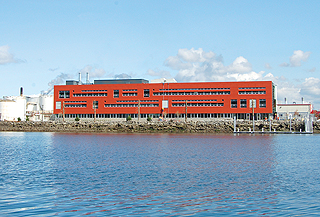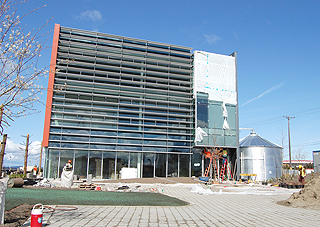|
Subscribe / Renew |
|
|
Contact Us |
|
| ► Subscribe to our Free Weekly Newsletter | |
| home | Welcome, sign in or click here to subscribe. | login |
Environment
| |
April 1, 2010
Tacoma building designed to get you thinking about water
Journal Staff Reporter
Along the east side of Tacoma's Thea Foss Waterway, a rust-red building catches your eye. The project, called Urban Waters, is designed to attract attention because one of its goals is to help people from different parts of Tacoma learn about water use, green construction and sustainability.
Devin Kleiner, project designer with architect Perkins + Will, said the project is shooting for LEED platinum but the team pursued a number of sustainable goals that did not target any points. The red facade, he said, is one example.
“It's kind of an environmental billboard,” he said. “(It) is a way to draw attention to the impressive information that's being created here, the research, by just drawing people from the other side of Tacoma to know what's going on here.”
Urban Waters is a 51,000-square-foot, three-story office and lab space organized around water testing and use. A 75-foot dock juts into the water so tenants can collect samples. The tenants are the city of Tacoma's Environmental Services Division, the University of Washington Tacoma and Puget Sound Partnership.
The building is opening in the next few weeks and its grand opening will be held in August. Construction cost $22 million. Turner Construction is general contractor.
Lorig Associates acted as developer for the nonprofit TES Properties. TES Properties was created by the National Development Council and issued $38 million in 63-20 bonds to finance the project. TES will lease space to the city, and the city will sublet space to other tenants. Tacoma will own the building in 30 years.
Office space on each floor is naturally ventilated, with lab space on the east side of the building on the second and third floors. A divisible conference space on the first floor is meant to host public events.
Challenges
Urban Waters faced a number of challenges. The building underwent a complete redesign in 2008 to reduce the size and cost. Originally, construction was slated to begin in June of 2008. Instead, it began in April of 2009, with construction set at the quick pace of 13 months.
Jim Goldman, project executive with Turner, said the team's focus and the owner's commitment allowed Turner to do a lot in a short period of time. “It's an extremely complex and diverse use,” he said. “Without that kind of commitment, it wouldn't have happened.”
Mixing office and lab space was tricky. There are 12 labs in the building, which required different equipment and needed to be built under different conditions. Two labs, for example, could not have any exposed metals.
Goldman said labs are “energy pigs” so having them in the building raised energy use. By choosing a low-flow fume hood for labs, the building should save 5 percent on its overall energy use.
Many developers are interested in Urban Waters and have toured it because of this focus and because the building was built “well within the range of similar use,” Goldman said.
Urban Waters is all about water use so that was a big focus in design. The building will use 46 percent less water compared to current state building code requirements; about 80 percent of the rainwater on site will be reused or absorbed.
Two 36,000-gallon cisterns are located prominently next to the entrance and will collect water from the roof and the lab system for irrigation and to flush toilets, providing 40 percent of the building's water needs. The parking lot is covered in porous concrete and water from it will be treated by nearby raingardens.
The building has a 12,000-square-foot planted green roof and a smaller green roof outside a conference space that will be used to test stormwater flow rates.
Each facade of Urban Waters is different to provide better daylighting and to manage heat gain. For example, motorized exterior shades will be programmed to automatically adjust to daylight and heat throughout the day on the west side, while shades on the south side will be fixed to maximize views.
Animal habitat is also provided. Tree snags should provide resting area for birds, and the team has also improved the water habitat for fish and other creatures.
A number of features are designed to engage the public. An interactive dashboard in the lobby will track the building's water and energy performance. Lights on the cisterns will show how full they are. The area around the building is public and will have art and signs to explain systems. Tours will also be offered. More than 400 people have toured the site so far.
The future
Goldman said Urban Waters is about the future while the industrial area surrounding it is about the past. The building is on a brownfield and surrounded by petroleum fuel terminals. In 2006, a multi-million dollar cleanup was completed on the Thea Foss.
The building will be 36 percent more energy efficient than a similar building built to code with the same uses. Urban Waters gets its heating and cooling from the earth through a geoexchange closed hydronic system with a series of heat pumps. Energy comes from hydroelectric Tacoma Power. The building has radiant floor heating and cooling. Goldman said the only carbon-based fuel in the building is for laboratory use.
Urban Waters aims to be a bridge between the past and the sustainable city Tacoma could become. “For a lot of buildings, once they're built, they slowly degrade from there,” Kleiner said. “I think this project will improve with age.”
Kleiner said the dashboard will help improve operations because people can measure the resources they are consuming. The green roofs will improve, as will the habitat for birds and fish.
Other products in the building serve as a connection to the past. Benches are made of granite curbs retrieved from a landfill. Timber along the lobby walls and ceilings was re-milled from Douglas fir beams salvaged from the demolished Tacoma Municipal Dock. Tree snags were retrieved from a site 20 miles away that a developer was clearing.
The building has features that could make it even greener in years to come. The roof is pre-wired for solar panels. The parking area is set up so half of the cars could be charged electrically.
Other team members include WSP Flack & Kurtz, mechanical, electrical, plumbing engineer; Swift & Co. Landscape Architects, landscape architecture; and AHBL, civil and structural engineer.
For more information, read these past stories in the DJC:
Center for Urban Waters to break ground Wednesday https://www.djc.com/news/en/12005001
Center for Urban Waters' mission: show how clean water and economic growth are linked https://www.djc.com/news/en/11206309
AIA picks this region's top 10 greenest projects https://www.djc.com/news/ae/11199546
Report calls for change in how people treat waterways in Seattle https://www.djc.com/news/en/11196300
Katie Zemtseff can be
reached by email or by phone
at (206) 622-8272.




